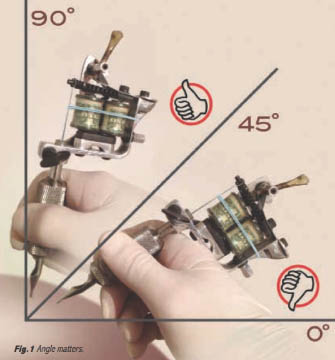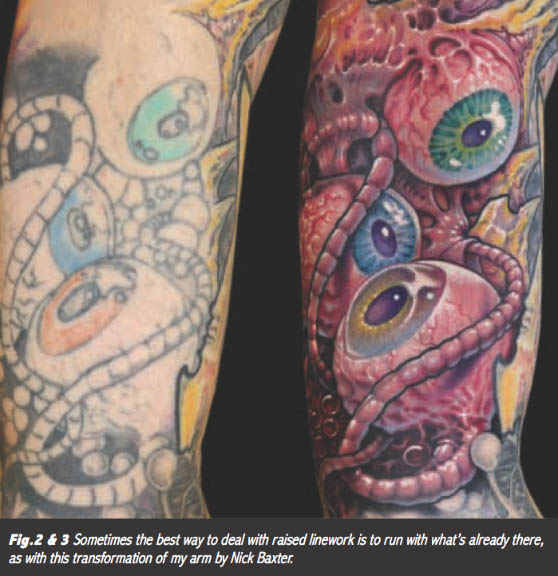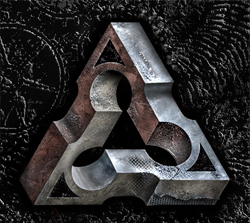Ask Guy 8 What Causes Bad Healing
Q: From Alex: I’ve had four tattoos done now by the same artist here in town. It’s a good shop and I like the work I’ve been getting so far. The last session was a little weird though, with the healing taking a lot longer than usual, especially on the lines. Now it’s been six months and the lines are pretty scarred. I mean, it’s like a full-on Braille tattoo, with the whole design being raised wherever there is a line. The shading healed just fine, but I haven’t gone back to have the color finished. The tattooist doesn’t know why it healed like that and says that maybe I’m keloid-prone, but all the other stuff he’s done on me healed just fine. What caused this to happen? And is there anything I can do to get it to go flat again?
A: There are some clients that are more prone to keloid scarring, particularly darker skinned collectors. But even in those cases, you usually won’t get much raising of the skin if the tattoo is done carefully. Raised or scarred lines are unfortunately all too common, and can be caused by a number of different things. Most of them are the tattooist’s responsibility, although in some rare cases it can be caused by a healing problem.
First, let’s eliminate the possibility of it being a healing issue that you are responsible for. I’ve had this happen once: A friend (who happens to be a world-class tattooer) did a large piece on my ribs, which featured lots of bold heavy linework. Most of it healed quickly, but there was a spot on my stomach, that spot where you wrinkle in on yourself when you sit down, that got a little red and funky. This spot ended up getting a thick raised scab that took several weeks to really disappear. During part of that time, the scab was surrounded by an angry red area, which I resolved with repeated applications of triple antibiotic ointment. Since the rest of the tattoo healed properly, we can conclude that it wasn’t a dirty work setup or anything like that—the infection was confined to a small spot where I had been sweaty and probably a little less than perfectly clean during those critical first few days. So in that case, it was my responsibility and could have been prevented.
Since in your case it’s the whole line that’s scarred, and the shading healed just fine, it’s unlikely that you got the entire tattoo infected. If that were the case, the shading would also be chunky and scarred looking. This suggests that the process of lining was where the damage happened. This will be most common with less experienced artists, or in some cases might happen at conventions or other settings where your tattooist has less than their normal amount of control over their work environment: Things can happen.
A hooked or barbed needle is probably the most common cause of a lining problem like that. Sometimes a needle will come out of the bag already damaged, and if your artist isn’t checking each one with an eye loupe there’s a possibility a bad one could slip past their defenses. In other cases, the needle will start out fine but pick up a hook as a result of being run accidentally against the bottom of an ink cap, or possibly against some other hard object on the work station. If there’s even a tiny hook in one of the points, that’s enough to cause a significant amount of damage to the skin, which usually results in raised lines. The artist may notice that the ink isn’t going in as it should and that there seems to be too much blood... Or maybe they won’t notice, depending on their level of experience.
The other common cause of scarred lines is hitting the skin at too shallow of an angle. Ideally the machine should be held at somewhere between a 90-degree and 45-degree angle relative to the skin (see Fig. 1). Once you start hitting the skin at less than a 45-degree angle you start running the risk of slicing it up just under the surface. Not only does this cause scarring, but your linework usually won’t be very sharp or black either.

Finally, it’s possible that the artist simply used too much power while lining. This is most common with less experienced artists, but it can happen to the best of us, especially while working with unfamiliar machines or in chaotic environments. Sometimes an artist will forget to turn down the power when moving from thicker skin, such as the outer arm, to a thinner-skinned area, such as the inner bicep. Even at the correct angle with pristine needles, excess power can cause scarring.
Unfortunately, raised lines usually don’t settle much with time or reworking. Laser removal might lighten it to nothing and soften its edges a bit, but the kind of keloid scarring we’re talking about is pretty persistent. Your best bet is to let it settle for a year or more, then either have the piece redone in a way that you’re happy with, such as the piece on my arm that Nick Baxter reworked in Fig. 2-3, or to have it covered in a way that cleverly absorbs the raised lines. Best to accept that they’re there, and to move forward.

Note to tattooists: if this happens to one of your clients, regardless of whose fault you think it is, a little understanding and a bit of free needle time to get things right will go a long way toward building a lasting and positive client relationship.
Q: From Carrie: I’ve just had the most horrible healing experience. The artist I went to is a professional with a good reputation. It’s a pretty big piece, a color portrait of Vincent Price on my outer thigh, and I like how it turned out. We did it all in one seven hour sitting, which was challenging to say the least. I’ve got several smaller tattoos, and the other artist who’s worked on me has told me I have great skin for color. But this one seemed wrong from the start. Before we were even finished the skin was drying out and cracking in places. By the end of the second day the whole thing was one giant red sore, so I went to the doctor and ended up on antibiotics. The scab I got was as thick as a cookie and took forever to fall off. Wherever the scab cracked I ended up with big holes in the color. The piece is now mostly healed but I can tell already that it’s pretty much ruined. Why did this happen? Is it my fault, and how can I get more work without knowing how to keep this from happening again?
A: This is a sad story that we’ve all heard far too many times: A good tattoo gone bad because of an infection. This can happen with both experienced and inexperienced artists, and is sometimes caused while the tattoo is being done, other times afterward, during healing. This isn’t about playing the blame game, but about getting to the root of the problem so it won’t occur again.
As with the question about raised lines, first let’s start by eliminating the possibility of it being your fault. As every tattooist knows, even an immaculately executed tattoo will then walk into the outside world and be exposed to all kinds of unclean things, often without the client being aware of this. One of the main reasons that tattoos get bandaged is to keep them from being too exposed during those initial critical hours when the skin is closing up its fresh punctures and sealing itself. A tattoo that walks out of the shop and straight to the bar to get shown off is far more likely to get infected than one that goes home to the shower and gets babied in private for four or five days. This can be a big factor. Secondly, the method you use to take care of it can make a big difference. There are many approaches to healing—I usually recommend little or no ointment and the piece kept clean and dry. But whatever you do, do it with freshly washed hands in a clean setting, not your grubby bar hands in a dirty bathroom. Be mindful of cleanliness in general as you handle your fresh ink, please!
Finally, there’s the question of your home environment. Anytime I hear about a collector having persistent healing problems, my first question is usually: Do you have dogs? You’d be surprised at how often the answer is yes. People get really comfortable with their pets and don’t think of them as being pathogen carriers, but hey, that dog was just rolling around on a dead squirrel. Cats can be just as bad. Again, just be mindful—if there is nobody else who can care for your animals during healing, wear loose clothing around them and wash your hands every time you’re going to handle your tattoo. And just for good measure, take these steps even if you don’t have animals. Simply paying attention will prevent most homespun infections.
If it’s not caused by one of these issues, then it’s possible it happened at the shop. I hate to point the finger of blame when there’s a bad heal, but every tattooist should acknowledge the possibility that they might be responsible. I’m not too proud to confess a couple times I’ve been at fault—I’ll share them here and hopefully help some of you prevent similar things from happening.
One thing all artists should look out for is patterns of bad healing, where a number of clients come back during a short period with similar problems. This happened to me once during my third year of tattooing, with three clients that I’d tattooed over a two-day period reporting problems. I examined all of their work and found that with each of them, the healing problems were with the black, but not in areas with other colors. That’s one of the first things you should look for when you get a bad heal— check to see if it’s localized in a particular color. I’ve never figured out what caused that bottle of black to get contaminated, but I did know one thing—throw it away. I then spent the evening going through all of my other ink bottles and cleaning them with alcohol and Madacide. The problem didn’t recur after that. But hey, I was responsible—that meant free touchups for all three clients. It’s good business and good public relations.
Another incident happened when I was working on someone at two different parts of the day, with a long stretch of time in between. After the first part of the session I covered the palette with plastic wrap, but by the time we resumed it had been under the sun for several hours, simmering. Even if all of the germs in those caps had originated with the client, brewing them under plastic like that was apparently a bad idea, since the tattoo healed horribly after weeks of heavy scabbing. So now my policy is that during breaks a palette gets covered with an inverted plastic plate, so light can’t get through, and can be left for a maximum of an hour before it’s time to toss it and re-pour. These extra steps are well worth it.
Sterile practices have been nicely standardized in the tattoo industry, and generally a client can tell at a glance if a shop is run in a way that is taking their health and safety into account. But hey, things happen. Sometimes it’s the client’s fault, sometimes not... and at times there’s no way to know. If you go back to the artist and show them what happened, hopefully they will be understanding enough to work with you in making things right. In your case, you’ll want to wait at least 3 months after the last scab has fallen off before going back in. If the heal was hard enough to result in scarring, try waiting 6 months and then doing the touchup over the course of two gentle sessions instead of one, just to give the skin a little break. With care you can get it looking better than the day it was first done.























